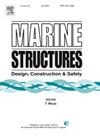Bearing capacity of helical pile group foundation in clay over silty sand
IF 5.1
2区 工程技术
Q1 ENGINEERING, CIVIL
引用次数: 0
Abstract
Recognized as a growing priority in offshore foundation engineering, helical piles demonstrate exceptional operational stability and lifecycle cost advantages, solidifying their role in modern marine infrastructure development. However, limited knowledge regarding the bearing capacity and failure mechanisms of helical pile group foundations under multi-directional loads in layered soils poses significant challenges for design and optimization of offshore wind platforms and other marine structures. This paper investigates the bearing capacity and failure mechanisms of the helical pile group foundation embedded in layered clay-over-silty-sand soil profiles using numerical simulation. The numerical model is validated against previously exhibiting published data before conducting a parameterized study. Key findings demonstrate that group configurations significantly enhance horizontal capacity compared to single piles, while clay-over-silty-sand stratification induces distinct delamination-type failure mechanisms of the soil around helical pile, contrasting with the global plastic flow observed in uniform clay. The study establishes the normalized bearing capacity envelopes for vertical-horizontal-moment (VHM) loading cases and provides algebraic equations to facilitate conservative design practices. These results offer valuable insights into optimizing the design of the helical pile group foundations for offshore wind platforms and other marine applications.
粉质砂上黏土螺旋桩群基础承载力研究
螺旋桩在海上基础工程中越来越受重视,它表现出卓越的运行稳定性和生命周期成本优势,巩固了其在现代海洋基础设施发展中的作用。然而,由于对层状土壤中螺旋桩群基础在多向荷载作用下的承载力和破坏机制了解有限,这对海上风电平台和其他海洋结构的设计和优化构成了重大挑战。本文采用数值模拟方法研究了层状粘土-粉砂地基中螺旋桩群地基的承载力及破坏机理。在进行参数化研究之前,对先前展示的已发表数据进行数值模型验证。主要研究结果表明,与单桩相比,群桩配置显著提高了水平承载力,而粘土-粉砂-粘土分层导致螺旋桩周围土体明显分层破坏机制,与均匀粘土中观察到的整体塑性流动相反。研究建立了竖向-水平弯矩(VHM)荷载情况下的归一化承载力包络,并提供了代数方程,便于保守设计实践。这些结果为海上风力平台和其他海上应用的螺旋桩群基础的优化设计提供了有价值的见解。
本文章由计算机程序翻译,如有差异,请以英文原文为准。
求助全文
约1分钟内获得全文
求助全文
来源期刊

Marine Structures
工程技术-工程:海洋
CiteScore
8.70
自引率
7.70%
发文量
157
审稿时长
6.4 months
期刊介绍:
This journal aims to provide a medium for presentation and discussion of the latest developments in research, design, fabrication and in-service experience relating to marine structures, i.e., all structures of steel, concrete, light alloy or composite construction having an interface with the sea, including ships, fixed and mobile offshore platforms, submarine and submersibles, pipelines, subsea systems for shallow and deep ocean operations and coastal structures such as piers.
 求助内容:
求助内容: 应助结果提醒方式:
应助结果提醒方式:


